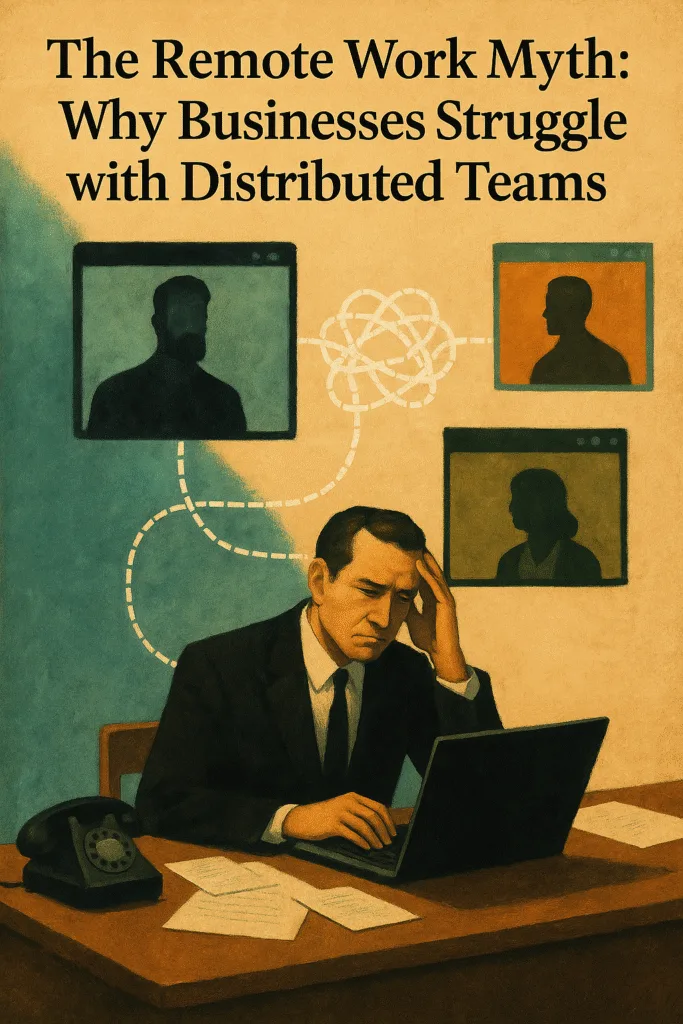The Remote Reality: Why Your Hybrid Workforce Is Failing—and What No One Wants to Admit
The Remote Reality: Why Your Hybrid Workforce Is Failing—and What No One Wants to Admit
By Ryan Gartrell, Business Consultant | Writer | Co-Founder of Angry Shrimp Media
In 2020, the message was clear: “We can all work from home.”
And on the surface, it worked. Productivity seemed to hold steady. Slack channels buzzed. Calendars filled. The commute vanished. Dress codes faded. It felt like evolution—efficient, flexible, humane.
But now, four years later, a new truth is surfacing quietly across executive teams, HR boards, and project retrospectives:
Remote work isn’t broken. But the systems behind it are.
And companies are paying the price.
The Illusion of Seamless Work

Remote work promised more balance, broader talent pools, and lower overhead. And for a moment, it delivered. But what looked like a long-term transformation was, in many cases, a temporary adrenaline rush.
The reality? Many teams now operate in a digital fog.
Projects fall through the cracks. Accountability gets blurry. Culture feels like a Slack emoji. And leaders—especially mid-level managers—struggle to bridge the gap between vision and execution.
Yet no one wants to say it out loud. Admitting that your remote operation is failing feels like a betrayal of progress. So instead, companies add more apps. More meetings. More frameworks. And the core problem gets worse:
You can’t patch a broken system with productivity software.
The Myth of Plug-and-Play Remote Culture
One of the great lies of the last decade is that remote work “just works” if you hire good people.
It doesn’t.
Remote success requires:
- Clear protocols for ownership and handoffs
- Documented decision-making processes
- SOPs that people actually follow
- Redundant systems for knowledge sharing
Without these, good people still fail. Not because they’re unqualified—but because no one told them what done looks like.
At Angry Shrimp Media, we’ve seen content campaigns implode because a Trello board became a graveyard. At Ryan Gartrell Consulting, we’ve diagnosed remote teams where product development cycles doubled because ownership was split between five Figma comments and zero decisions.
You can’t scale alignment through vibes.
Lean AI® Insight: Systems Make Remote Work Possible
At RyanGartrell.com, our Lean AI® methodology is designed specifically to diagnose this chaos. We analyze not just tasks—but the systems, permissions, and communication pipelines behind them.
- Do you know who owns every workflow?
- Do you have operational dashboards instead of anecdotal updates?
- Do your tools support structure—or just simulate it?
When remote work succeeds, it’s because operations were built to support it. When it fails, it’s because someone assumed Wi-Fi was a substitute for structure.
What Gets Lost in the Remote Fog
When teams go hybrid without real design, here’s what usually disappears:
- Onboarding: New hires are welcomed by broken Google Drives and 700-page Notion boards.
- Context: Decision rationale is lost to unread threads and private Slack DMs.
- Accountability: Tasks are assigned but never owned. Deadlines drift.
- Innovation: Brainstorms happen in isolation, without friction or synthesis.
- Culture: Connection becomes transactional. Loyalty disappears.
These aren’t side effects. They’re the system working as designed.
Why Leaders Don’t See It
Here’s the catch: remote failure is quiet.
There’s no shouting. No visible discontent. Just erosion.
Founders see work getting “done,” but not progress. Managers spend 40% of their time checking status. Employees burn out while feeling invisible.
It’s not chaos—it’s quiet disengagement.
And it’s why so many companies are returning to office mandates under the false assumption that presence equals performance.
The problem wasn’t the flexibility. It was the lack of infrastructure.
Co-Branded Insight: Creative Teams and Operational Teams Need Different Tools—But the Same Systems
At Angry Shrimp Media, our digital teams thrive in asynchronous sprints. But those sprints only work when structure is agreed upon.
At Ryan Gartrell Consulting, our systems audits uncover inefficiencies hiding in “good enough” habits. Remote work magnifies those inefficiencies.
The throughline? You can’t wing it. Creative freedom and operational discipline aren’t opposites. They’re co-dependent.
Your team doesn’t need a better calendar. It needs clarity. Ownership. Rhythm.
Conclusion: Don’t Kill Remote—Fix What’s Broken
The future of work isn’t remote or in-office. It’s intentional.
Remote work fails when it’s bolted onto legacy systems that were built for hallways and cubicles. It thrives when it’s architected with purpose.
At RyanGartrell.com and AngryShrimp.com, we help companies build that architecture—from creative to operational, from campaign to code.
The problem isn’t the location. It’s the design.
And it’s time to rebuild.
External Reference:
Harvard Business Review: Remote Work Isn’t Going Away—But Your Culture Might Be
